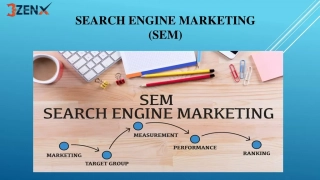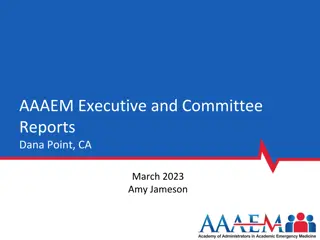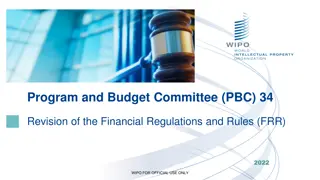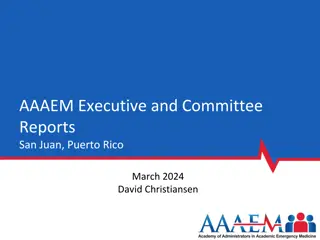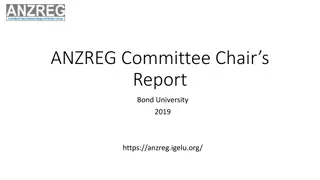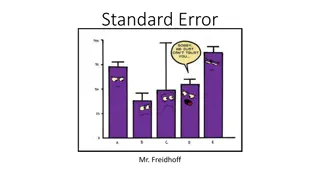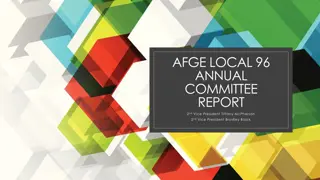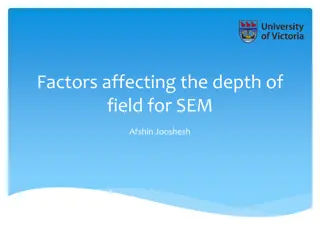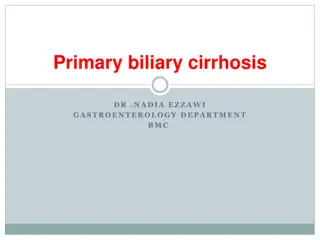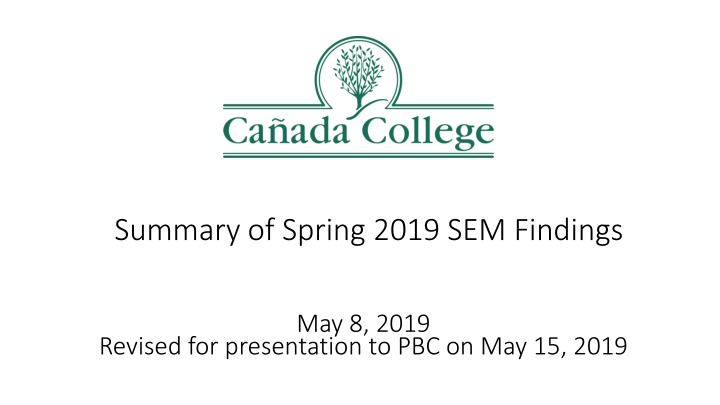
Spring 2019 SEM Findings: Enrollment Trends and Recommendations
Explore the key findings from the Spring 2019 SEM report, highlighting a decline in headcount and FTES over five years. Discover insights into face-to-face and online unit enrollment trends, alongside recommendations for the future. Access meeting materials and data on the PRIE website for detailed information.
Download Presentation

Please find below an Image/Link to download the presentation.
The content on the website is provided AS IS for your information and personal use only. It may not be sold, licensed, or shared on other websites without obtaining consent from the author. If you encounter any issues during the download, it is possible that the publisher has removed the file from their server.
You are allowed to download the files provided on this website for personal or commercial use, subject to the condition that they are used lawfully. All files are the property of their respective owners.
The content on the website is provided AS IS for your information and personal use only. It may not be sold, licensed, or shared on other websites without obtaining consent from the author.
E N D
Presentation Transcript
Summary of Spring 2019 SEM Findings May 8, 2019 Revised for presentation to PBC on May 15, 2019
Members of the SEM Committee Tammy Robinson, VPI, co-chair Karen Engel, Dean, PRIE, co-chair Hyla Lacefield, Academic Senate President Diana Tedone-Goldstone, Librarian, Academic Senate VP Jeanne Stalker, Classified Senate President Lezlee Ware, Distance Education Coordinator, Faculty Paul Naas, CE Faculty Marisol Quevedo, Promise Program Coordinator Mayra Arellano, College Recruiter Ruth Miller, Registrar and Admissions Char Perlas, VPSS Max Harman, Dean of Counseling James Carranza, Dean, H&SS Adam Windham, Dean, STEM Leonor Cabrera, Dean, BDW David Reed, Dean, ASLT Marketing and Community Relations (Dave McLean and Megan Rodriguez-Antone President Jamillah Moore Graciano Mendoza, VPA
All meeting materials and data posted on the PRIE website: https://canadacollege.edu/prie/ enrollmentmanagement.php
Contents What is the data telling us? What did we learn about the programs and topics we explored? What questions remain? Synthesis and emerging recommendations
Headcount: down 4.6% in 5 years Unduplicated Headcount (students) by Academic Year 11,800 11,695 11,641 11,600 11,446 11,400 11,278 11,200 10,947 10,919 11,000 10,800 10,600 10,400 10,200 10,000 2013-14 2014-15 2015-16 2016-17 2017-18 2018-19
FTES: down 16% in 5 years Full Time Equivalent Students (FTES) 4,400 4,224 4,200 4,102 4,051 3,956 4,000 3,800 3,664 3,559 3,600 3,400 3,200 2013-14 2014-15 2015-16 2016-17 2017-18 2018-19
Average face to face units taken: Average online units taken: down 54% in 5 years down 38% in 5 years Hybrid Face to Face Online % of % of % of Average Units Average Units EnrollmentsAverage Units Enrollments Enrollments 14% 9.0 63% 8.8 23% 4.8 2017-18 14% 8.7 67% 9.3 19% 4.6 2016-17 14% 8.3 70% 9.4 16% 4.3 2015-16 12% 8.5 72% 9.2 16% 4.3 2014-15 12% 17.5 75% 18.7 13% 8.1 2013-14 12% 17.5 78% 19.0 10% 7.8 2012-13 Includes only students who enrolled in the respective course modality Average Total Units Enrolled Per Student Per Academic Year
Major Demographic Shift: County population is getting older Ca ada s share of college-age residents has remained the same 2013 2014 2015 2016 2017 San Mateo County Population Ages 18-35 168,589 168,746 167,426 165,591 164,205 Ca ada Students (unduplicated) 11,446 11,695 11,641 11,278 10,947 Share 7% 7% 7% 7% 7%
Enrollment management in the age of resource constraints resource constraints
Enrollment management in the age of resource constraints resource constraints more enrollment more resources
Enrollment management in the age of resource constraints resource constraints simple harmonic motion
Enrollment management in the age of the completion agenda completion agenda
Enrollment management in the age of the completion agenda completion agenda Recruitment Persistence Completion
Enrollment management in the age of the completion agenda completion agenda Recruitment Persistence Completion START Strong STAY Strong FINISH Strong
Recruitment: 66% down to 34%?? 5,000 4,294 4,051 3,700 4,000 3,100 2,830 3,000 2,633 2,500 1,869 1,738 1,732 2,000 1,679 1,587 1,572 1,257 1,000 - 2012 2013 2014 2015 2016 2017 2018 Number of Applicants to Ca ada Enrolled at Ca ada Within 1 Year of Applying
Persistence Fall to Spring Persistence Rate 2018-19 College for Working Adults 91% STEM Center 89% Promise Scholars 88% First time full time students 83% Canada home campus students only 63% College Overall 57%
Completion 2013-14 2014-15 2015-16 2016-17 2017-18 Degree completion 422 463 486 585 558 Transfer 260 293 276 307 341 Certificate completion 400 332 244 292 372 TOTALS 1,082 1,088 1,006 1,184 1,271 Duplicated data
Top Majors Declared 2013-18 Completers in 2018 Top Majors (2013-18) Students Undeclared Major AA/AS Degree Business - Administration (2884) & Mgmt (539) Education and Human Development Psychology Computer Science Engineering Allied Health Fashion Kinesiology Nursing English Biology Accounting General Liberal Arts & Science Medical Assisting Radiology Technology Multimedia Art Interior Design Sociology Administration of Justice 4,002 3,423 2,070 1,989 1,235 1,143 964 923 882 860 831 826 815 691 653 588 586 581 537 475 50 86 46 14 10 33 23 8 0 5 10 10 0 27 14 63 27 0
Regional Share of FTES College Business & Management Information Technology Canada DeAnza Foothill San Francisco San Mateo Skyline 84% 107% 131% 58% 150% 83% 59% 140% 113% 78% 150% 20%
Topics Explored College for Working Adults Dual Enrollment and Middle College Online Education Career Education International Students KAD and the new Building 1 STEM Center Innovations
College for Working Adults (CWA) 250 students with above average completion rates Cohort Scheduling: classes are offered at specific times Wrap-around services (counselor; tutors (2) graduates of the program who are embedded who also serve as TA s); may add a third psychology tutor) Communication: Canvas class for the CWA community Students can communicate with each other and the program; Announcements posted there; Calendar is posted there for tutor sign-ups
Dual Enrollment 168 dual enrollment students 107 Middle College 762 other concurrent enrollments Students with early college experience have better outcomes: More likely to enroll in college Higher course success rates Greater program completion rates Goal: Increase college and career exploration opportunities for student from feeder high schools San Mateo CCD College of San Mateo Canada College Skyline College Total Public High School Graduates in San Mateo County High School Graduate Enrollment High School Graduate Enrollment High School Graduate Enrollment High School Graduate Enrollment High School Graduating Years Take Rate Take Rate Take Rate Take Rate 2008/09 2012/13 28,693 15,594 54% 7,693 27% 5,040 18% 8,736 30% 2009/10 2013/14 29,395 14,379 49% 6,809 23% 4,299 15% 7,884 27% 2010/11 2014/15 29,747 14,078 47% 7,082 24% 4,742 16% 8,018 27% 2011/12 2015/16 29,951 13,701 46% 7,142 24% 4,851 16% 7,734 26% 2012/13 2016/17 30,313 13,503 45% 7,271 24% 4,932 16% 7,681 25%
Online Education: FTES by Instructional Modalities 2012-13 2017-18 Hybrid Only 0.4% FTF and Hybrid 15% FTF and Hybrid 19% Hybrid Only 1% Face-to-Face Only 40% Online Only 8% Online Only 21% Face-to-Face Only 52% FTF, Online, and Hybrid 8% FTF and Online 12% FTF and Online 19% FTF, Online, and Hybrid 5%
Online Education Online enrollment is increasing, while face to face is declining Divisions and departments to follow clearer guidelines when deciding what to offer online Committee recommendations re college values for online ed: Make scheduling decisions and whether to offer a course online with (different types of ) student needs and related data in mind Always preserve face-to-face options as much as possible We don t want to be an online college we want to ensure students have options in their learning modalities We have equity issues: access and course success We must provide online student supports (Net Tutor, etc.) We much require faculty teaching online to participate in online teaching pedagogy training regularly
Career Education Headcounts are consistently 3,500+ Flagship design and Education programs are a known draw for the campus Growth and innovation of programs is critical Need a greater presence and course offerings downtown Marketing programs is a major effort that needs ongoing support Early exposure to design or careers for youth and career changers needs to be scaled Partnerships with 4-years could help bring some BA courses to campus & deepen pathway (SEM Committee supports exploration of partnerships with SJ State (Digital Art) and SF State (ECE)) Partnerships with employers are critical but faculty can only do so much Campus alignment and strengthening of relationships with employers and expansion of job shadowing, internships, job placement functions across Divisions and with the Career Center is critical
International 136 students per year now can grow! Target markets: Au pairs, SVIEP students, families in the local area Major reasons students come: our programs (design, STEM); our location in Silicon Valley; our small size and personal attention Challenges: our name (confusion) Opportunity: Hybrid program: students do year 1 online from their home and year 2 here on campus
Kinesiology, Athletics, Dance (KAD) 1,116 current headcount (KAD) Headcounts have fallen by 36% over the last five years: Repeatability rule change impacted FITNESS enrollments Lack of facilities (now) Student outcomes are all above average Program provides aligned counseling, regular progress reports, information via workshops, creates culture of belonging Great opportunities exist with the new building, but how can we afford to invest in new faculty, coaches and programs?
STEM Center 886 students participated in STEM activities in 2017-18 Higher persistence rate: 89% Programs include many best practices also indicated by CUNY-ASAP and Guided Pathways: Career exploration Retention specialist and aligning counseling support Cohorting, events, and the physical location of the STEM Center create a sense of belonging Supplementing Instruction: EPIC, tutoring
These programs (CWA, STEM, Athletes, Promise) have things in common: Students are in a cohort or in a defined program with peers Counselor(s) are aligned with and highly knowledgeable of the program and its requirements Success Teams: Counselors, Retention Specialists work together Student level data is reviewed regularly (SEPs +) and students monitored and kept informed re what they need to do to achieve their ed. goals Supplemental Instruction (EPIC; minimum tutoring expected) Students are encouraged to attend full time (12-15 units/term) Instructional faculty are aligned with the program offering contextualized support Career exploration and development is baked in to the student journey
Guided Pathways QFE Action Items Complete-ability Increased accuracy of Student Education Plans which can inform course scheduling Grouping degree programs into Interest Areas or Meta Majors Optimization of the class schedule to avoid class cancelations and conflicts Alignment of support services with interest areas Implementation/expansion of various high school engagement strategies: Dual Enrollment, Summer Programs, Outreach Events, etc Modification of the current Priority Enrollment Program (PEP) to better serve incoming students
Guided Pathways QFE Action Items cont Expansion of cohorts via learning communities Expansion of Support (including Job Placement and Career assistance) and Instructional Programs Identification of job placement data tool Streamlining the application process Providing the needed support for FAFSA completion Development of a First Year Experience program Development of Bridge Programs
SEM Committee Recommendations Continue working on the plan and key performance indicators over the summer resulting in a draft SEM Plan submitted to PBC in early fall 2019 Get clearer on the distinction between the Strategic Enrollment Management and strategic initiative planning and implementation generally A new task force for aligning outreach has been formed, with Mayra Arellano in the lead which will also meet over the summer and consider: How to best coordinate all of the outreach activities and contacts currently happening to maximize impact and be more efficient resulting in a Campus-wide Outreach Plan by end of summer What the key messages are about the College and to which audience(s) How the College could conduct a thoughtful process for considering whether or not to pursue changing the College s name

